Crypt of the NecroDancer Review
It’s not often that I look at a game and think “goodness me, this would make a brilliant arcade machine.” About the only thing the humble arcade cabinet can offer to gaming right now is the chance to play with peripherals that are too outrageously big and expensive to keep in your closet alongside your plastic Rock Band bits and pieces, but it’s rare that such an offer is strong enough to overcome my natural distaste for loud rooms, suspiciously sticky controllers, and an overwhelming smell of hot plastic.
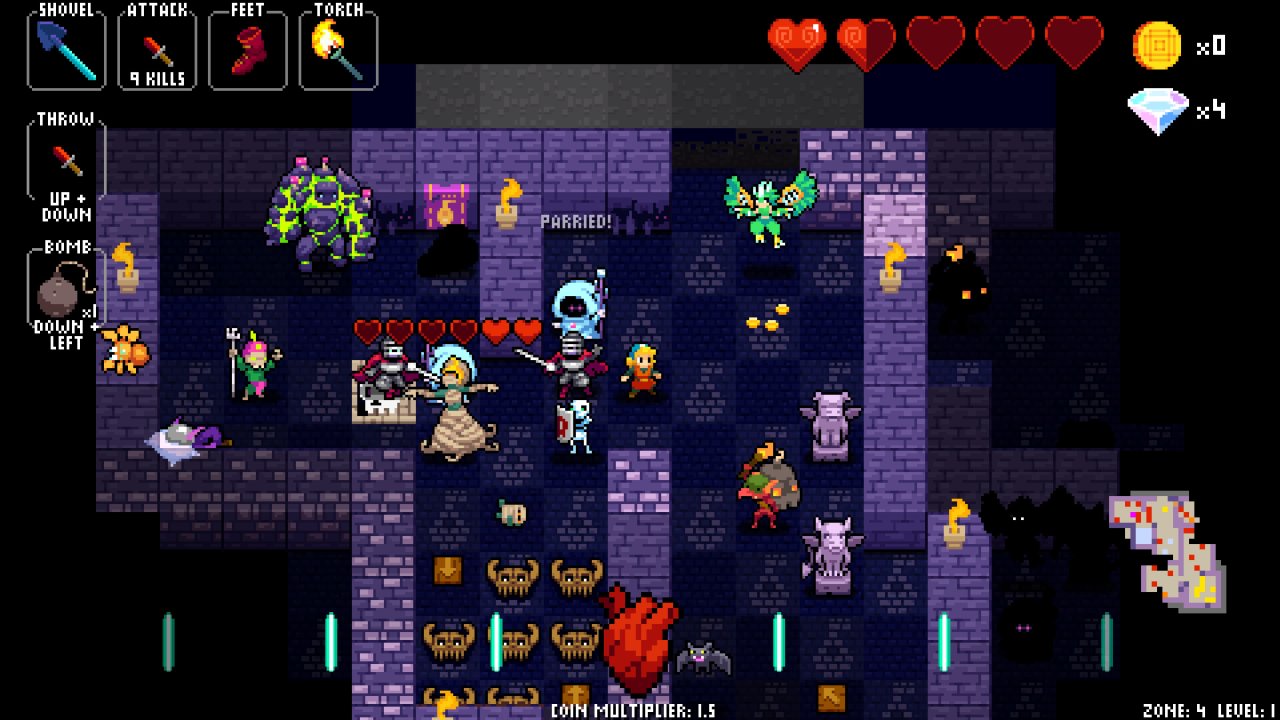
Consider it an unconventional mark of praise, then, that I’d go out of my way to play on a Crypt of the NecroDancer arcade machine. I can see it now: a matte-black repurposed DDR cabinet, impractical and heavy, painted with the lurid artwork of the loading screen, waiting to explode with light and sound at the slightest provocation. Even the intro cinematic is the kind of animated, condensed affair that you could easily see looping over and over in a dim corner somewhere: Cadence, the game’s protagonist – I hope you like music puns, by the way – is out digging in a graveyard looking for the titular crypt, when she finds it by way of a sudden collapse. The Necrodancer finds her near-death, and being a public-spirited sort who needs no excuse to practice his art, forces her ailing heart to beat to the music in the crypt – a small price to pay for free medical attention – before vanishing into its depths. Such is the slightly convoluted explanation for Crypt of the NecroDancer’s main gameplay premise: classic tile-based roguelike gameplay timed to the beat of Danny Baranowsky’s remarkably varied soundtrack.
In a roundabout sort of way, Crypt of the NecroDancer’s rhythm-driven gameplay not only makes perfect sense, but makes me wonder why nothing like it has been tried before. Combat in traditional roguelikes has always been something of a turn-based dance; carefully stepping here and there, into recently-vacated space and away from encroaching foes, to maximise damage and dodge enemy attacks. Necrodancer – I’m just going to call it Necrodancer, because stylised capitalisation is the work of language heretics – simply speeds things up a little bit and designs itself to fit. Instead of having all the time in the world to ponder your next move, you and everything else in the dungeon are compelled to move to the inexorable beat of the song. Suddenly, through this one small change, the game becomes an intense exercise in constant planning, thinking ahead, and split-second decision making. Situations that you could have once tackled over the course of a few minutes now have to be solved in seconds, all while moving to that overpowering beat. Within moments of entering a room, you need a plan. Step left, step up, lunge at the skeleton, dig out a wall to skip a beat, cut the slime that just moved into range, dodge the fireball, step around the trap tile… whoops, looks like you didn’t take that wind wizard into account, you dolt. Now you’ve been pulled off course, you’ve missed a beat, dropped your coin multiplier, and you’re about to be attacked from three different directions. You have about twenty-five milliseconds before the next beat hits and those attacks land. It’s extraordinarily exhilarating, being put on the spot like this, and there’s nothing more satisfying than fighting your way out of a chaotic melee without taking a scratch.
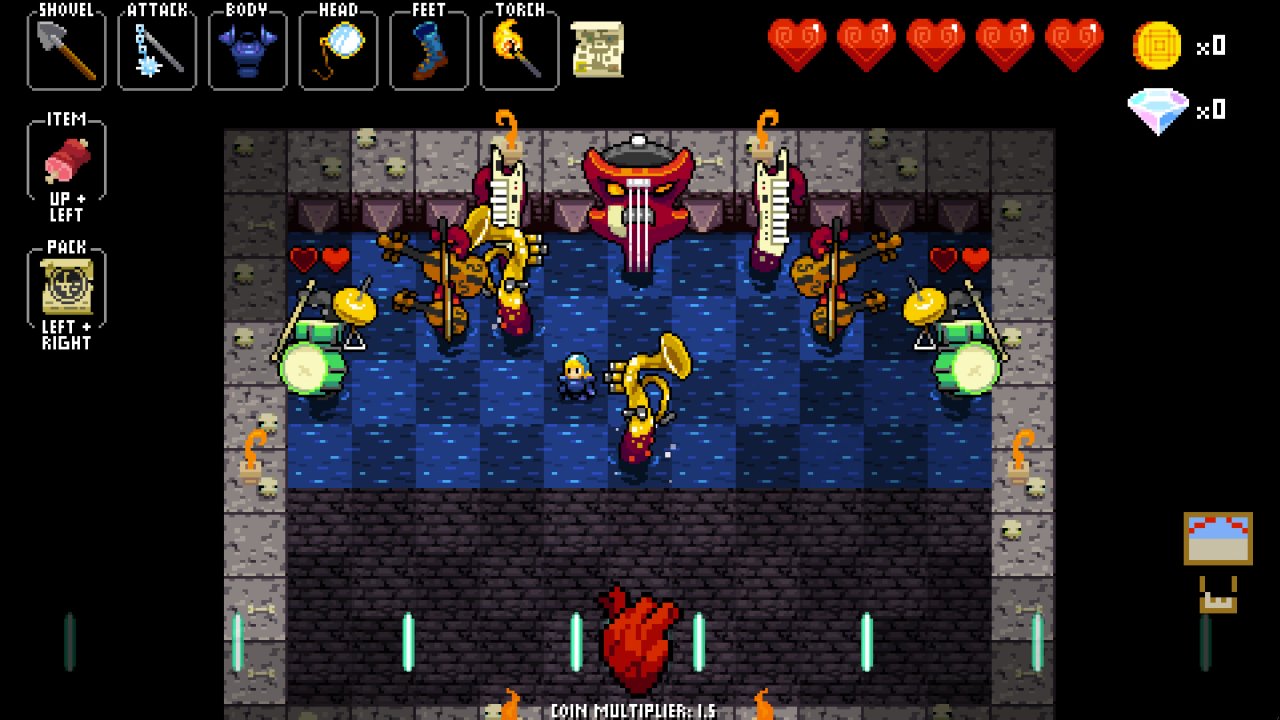
That’s the truly beautiful thing about Necrodancer’s combat: it’s almost always possible to handle a fight in such a way that you completely evade damage. Every enemy moves according to a certain pattern, some fairly simple, some much more obtuse, and the key to survival is to dance around them; to step nimbly out of reach on the beat before a scything attack, to dart in and strike while they’re recoiling, to move warily around them until the perfect opportunity. Most of this is opportunistically played out in the heat of the moment, but there are certain combinations of moves you can memorise to deal with particular scenarios – if you’re boring, that is. You’ll have to learn to dance on the fly too, at least if you plan to beat the game at some point, because Cadence is as fragile as a sheet of plate-glass being carried across a busy road, which I suppose is inevitable when you go out on an adventure in your gardening gear. In the very first level of the very first zone, there are certain enemies that can kill you in a single hit, and it only gets harder from there. Initially it feels ruthlessly unfair, punishing you needlessly for even the slightest slip-up, but as you learn enemy patterns and weapon behaviours, it smooths out into a more reasonable – but still, of course, exceptionally challenging – experience. It’s a brand of difficulty that will seem very familiar to any seasoned Spelunky player, in the sense that death is always avoidable but nevertheless entirely to be expected, and first and foremost your fault. Oh, it may be down to a matter of ignorance sometimes, but the learning experience is all part of the fun.
And since I feel obliged to put good design on a pedestal whenever I see it, let’s appreciate for a moment the way a large amount of Necrodancer’s upgrades affect you in ways other than boring stat boosts. If it was just a case of sharper swords or shinier armour then Necrodancer would still be great, if a little homogeneous, but so many upgrades are specifically engineered to force you to change how you think spatially; boots that leap two spaces at a time, weapons that lunge forward or knock enemies back, spells that only hit specific squares, a drum that lets you stand still for a beat, and so on. It’s brilliant, not necessarily for throwing in extra complications but for throwing in the kinds of extra complications that you can solve at a glance, provided you realise what they entail. You’ll die countless times because you forget about these little modifiers, stopping to attack by accident or lunging in front of a runaway bus, but with sufficient practice they can be managed with the kind of immediacy that doing elaborate mental maths could never achieve.
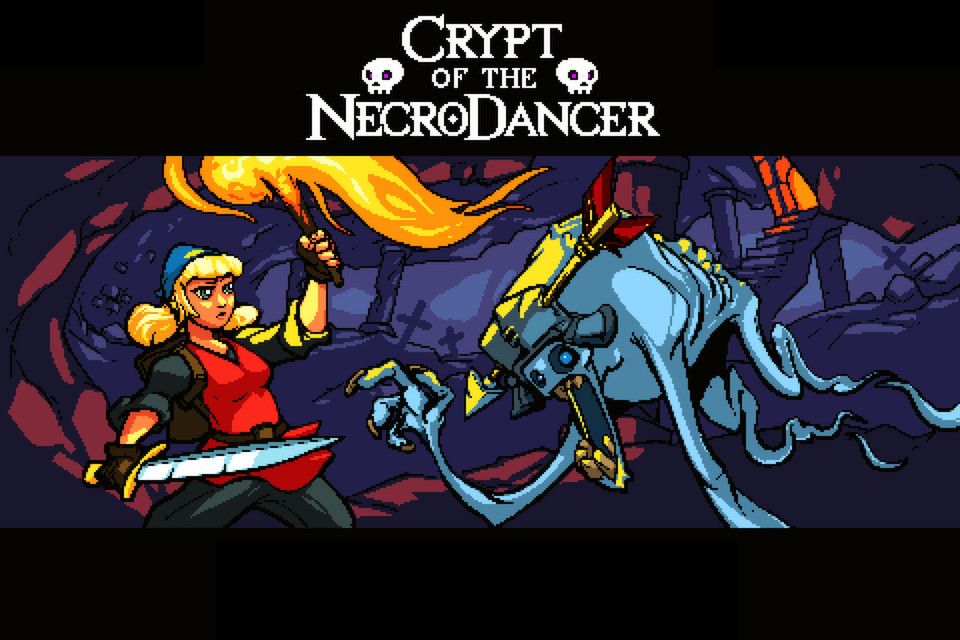
Speaking of forgetting things, I really do wish there was some indication on your character – difficult, given the level of detail we’re working with, but probably not impossible – as to the usable items you currently have equipped; when you can’t take your eyes off the dance floor for minutes at a time, it’s easy to forget that they’re there. The game helps a little bit with its UI design, but I still find a vast number of my runs end with me staring at the ‘game over’ screen, realising that I could have made it out alive if I’d just remembered I was capable of casting the Deus Ex Machina spell. Still, at least I knew what the Deus Ex Machina spell did when I picked it up. That’s one nice feature that sets Necrodancer apart from a lot of other roguelikes and usually goes unappreciated: you can actually play it without constantly diving into the codex or having the wiki permanently open on your other monitor. Moving next to an item will momentarily show a description of its functionality – often a proper concise description too, not the cryptic nonsense that Binding of Isaac teases you with – and while the input combinations for activating equipment aren’t always intuitive, the game does have the decency to spell them out for you as part of the UI. Some item descriptions are still a bit obtuse or simply consist of “???”, but I suppose it can’t hurt to have a bit of an air of mystery here and there.
I also have a problem with Necrodancer’s permanent upgrade system: specifically, the part where it exists. In between runs you can spend a semi-permanent currency – diamonds, for no particular reason – on bonus health, a better coin multiplier, more items to go into the item pool, that sort of thing, and it kind of rubs me up the wrong way. There’s nothing, at least theoretically speaking, stopping you from beating Spelunky or NetHack on your very first try; the barriers are all in your head, and progress is dependent on your ability to lower them. They’re long, torturous roads of self-improvement, and success is sweetened by knowing you’re only here because you learned from your hundreds of failures – with maybe a little helping hand from the random number generator here and there. Necrodancer takes that warm sense of self-worth and gobs in it like a bitter cafeteria cook. Every time I completed a zone, I just couldn’t silence the little voice that wondered how much of it was my own doing. Would I have still won without that extra heart container? Would that chest have still been there if I hadn’t tipped the odds in my favour? I bought my victory. Bought it. And that’s every bit as hollow as it sounds.
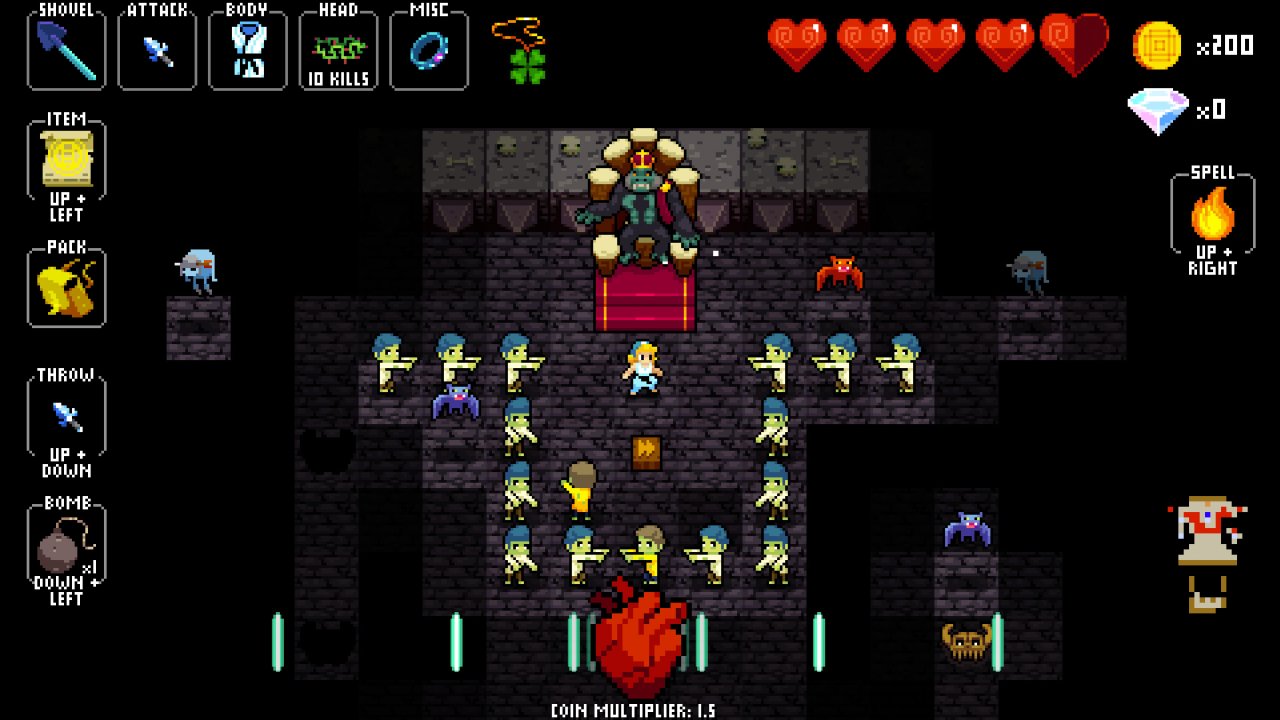
Fortunately, all this faffing about with individual zones and upgrade systems is, in the major scheme of things, really little more than an overwrought tutorial designed to ease all the big babies into the meat of the game without scaring them off: buy more equipment once you know how to use the stuff you already have, buy upgrades so your constant embarrassing botched runs don’t feel like complete wastes. Necrodancer rightfully nullifies the whole system with what I like to call the ‘real’ gamemode, which floods the equipment pool with everything, throws away the asinine upgrades and pushes you through all four zones back-to-back. Here – where the tension has the time to ratchet up, where Cadence can actually accrue value, where the full insanity of the game’s items can be unleashed – is where Necrodancer truly shines, as a game that not only expertly tickles all my roguelike spots but also takes a fascinating core mechanic and never stops running.
And when I say ‘never stops running’, that’s only sixty to seventy percent hyperbole. End-to-end, Necrodancer isn’t a particularly long game – you could finish a full run in a lunch-break, and trust me when I say that’s not going to happen often – but between its exceptional difficulty and the way it stuffs itself silly with extras, it’s a serious contender if you ever have to go into space for six months and shipboard policy demands that you only bring one game.There are a couple of extra gamemodes stowed away, including a daily challenge – more proof that Spelunky is essentially the perfect template for all roguelikes -an especially forgiving dance-pad mode and local co-op, but the real meat and potatoes are the extra characters. Cadence is only one of numerous adventurers looking to delve into the crypt – I suppose that’s only natural, given it’s the only place in this fantasy world with a working dance floor – and much like The Binding of Isaac, some of these characters radically change how the game plays: Eli has infinite bombs but can’t use weapons, Monk can’t touch gold, Dove can’t kill anything, so on, so forth. That having been said, some feel like kind of a cop-out in the sense that they just have obscenely difficult conditions loaded onto them. Bolt, for instance, just has to move everywhere at a finger-destroying double-time. Cadence’s grandmother, Aria, essentially fills the role of an NG++ mode, so there’s no question that by the time you’ve unlocked her you’re pretty slick at the game, but even so, a character who dies instantly upon missing a beat just seems cruel and crudely designed.
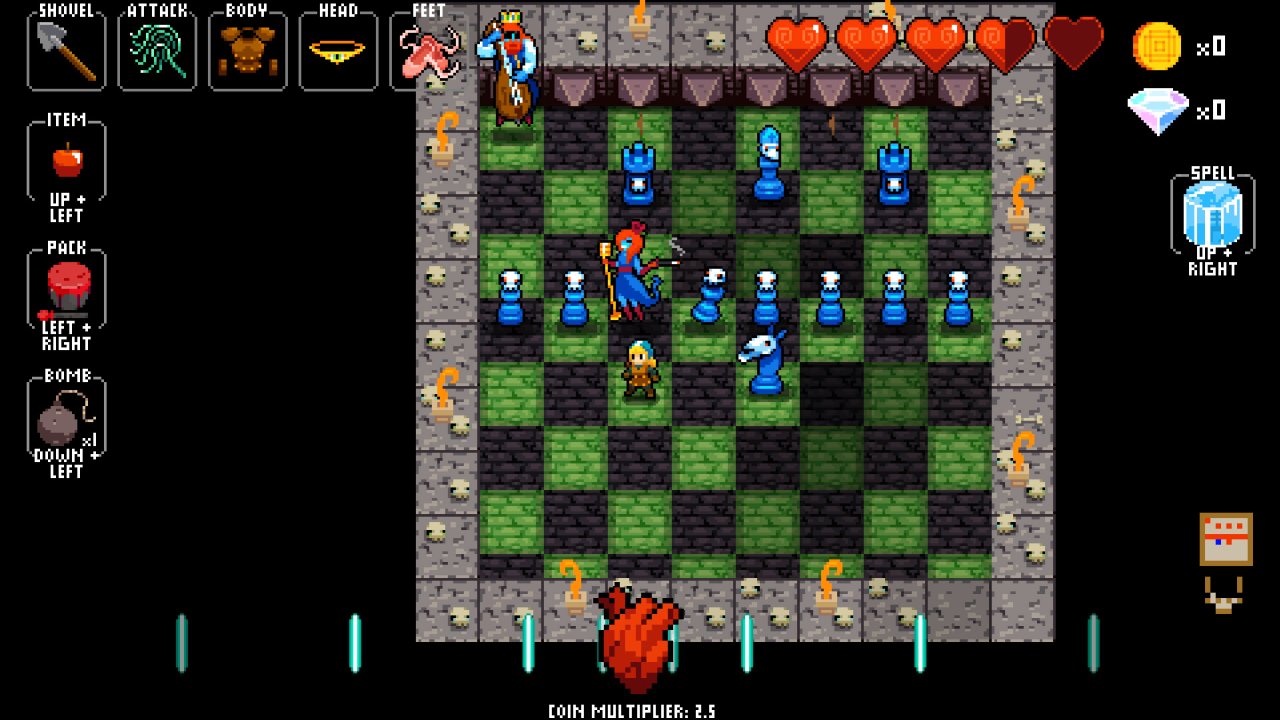
On the musical side, the game has certainly expanded quite a bit since its Early Access debut: aside from the extra tracks added for zone four, you also get two bonus playable soundtracks consisting entirely of EDM and metal covers of Danny Baranowsky’s superb OST, but without meaning any disrespect to the chaps who worked on them, they both kind of suffer from the need to conform precisely to the constant beat. If you really want you can even feed your own music into the game, but unless your track has a strong, distinct beat with absolutely no change of pace throughout the entire song, you’ll probably just find yourself staring at the bottom of the screen through the whole level, trying to make sense of the batty timing the algorithm spat out.
Finally, there’s the plot, which surprisingly enough actually extends beyond the intro cinematic. Necrodancer seems acutely aware that the potential for storytelling on the randomly-generated dance floor isn’t great – unless some kind of digitized rock-opera dance breaks out, which on reflection I would probably love to bits – and consequentially it opts to communicate by ramming short animated cutscenes down your throat at the end of every zone. I can’t fault Necrodancer for its pacing here, winding down appropriately after a probably stressful boss fight, but it’s going to take more than a handful of forgettable cutscenes to make me care about the plight of the tiny sprites that hop around on-screen. Disappointingly, despite the cutscenes being largely of the ‘here, have a back-story dump’ variety, only Cadence, her mother and her grandmother get any at all, which seems like kind of a missed opportunity with Uncle Shovel-Hands sitting right there. Maybe Necrodancer needs to embrace the same strategy as the games it visually resembles and just supplement itself with a cheesy Saturday morning cartoon.
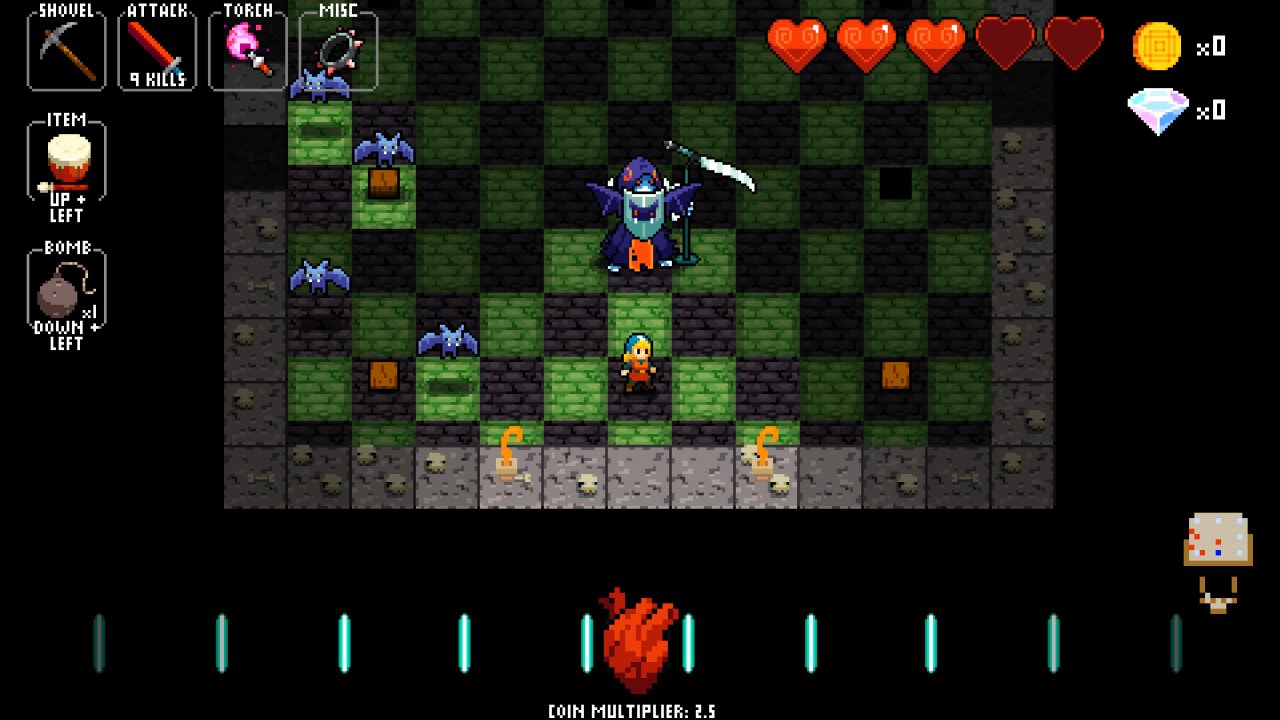
In any case, Necrodancer is like any other roguelike in that the greatest stories are the ones its emergent gameplay generates, to be told excitedly the next morning to a disinterested fellow fan. Who gives a damn about what happened to Cadence’s missing dad? Let me tell you in excruciating detail about the train-wreck in slow-motion that was this morning’s daily run.
But let’s face it: the story doesn’t hurt anybody, and neither do the vast majority of things I’ve whined about here. Crypt of the NecroDancer is a rare example of a game that carefully marries a refreshing central mechanic – one that’s the very epitome of ‘easy to learn, hard to master’ – with the kind of intelligent, textbook design that I wish I could show to everybody else jumping on the roguelike bandwagon. It gives rhythm-action games a future beyond rapid colour-matching minigames, it gives roguelikes a future beyond slapping randomly-generated levels on a half-baked video game, and frankly I’ve never seen anything like it. Great stuff, guys.
Still deliberating over that dance pad though.
